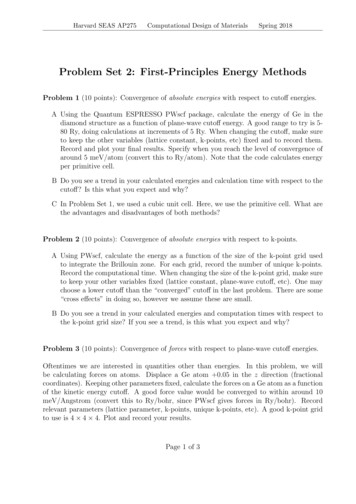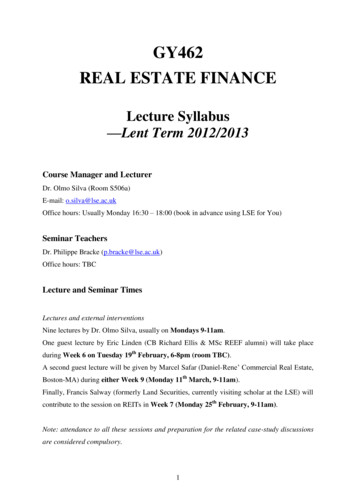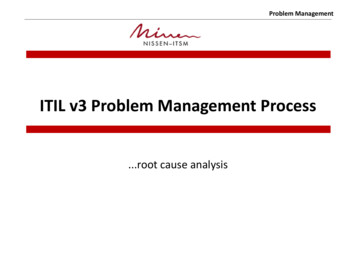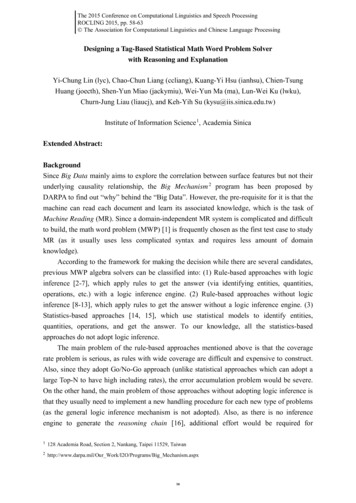
Transcription
Harvard SEAS AP275Computational Design of MaterialsSpring 2018Problem Set 2: First-Principles Energy MethodsProblem 1 (10 points): Convergence of absolute energies with respect to cutoff energies.A Using the Quantum ESPRESSO PWscf package, calculate the energy of Ge in thediamond structure as a function of plane-wave cutoff energy. A good range to try is 580 Ry, doing calculations at increments of 5 Ry. When changing the cutoff, make sureto keep the other variables (lattice constant, k-points, etc) fixed and to record them.Record and plot your final results. Specify when you reach the level of convergence ofaround 5 meV/atom (convert this to Ry/atom). Note that the code calculates energyper primitive cell.B Do you see a trend in your calculated energies and calculation time with respect to thecutoff? Is this what you expect and why?C In Problem Set 1, we used a cubic unit cell. Here, we use the primitive cell. What arethe advantages and disadvantages of both methods?Problem 2 (10 points): Convergence of absolute energies with respect to k-points.A Using PWscf, calculate the energy as a function of the size of the k-point grid usedto integrate the Brillouin zone. For each grid, record the number of unique k-points.Record the computational time. When changing the size of the k-point grid, make sureto keep your other variables fixed (lattice constant, plane-wave cutoff, etc). One maychoose a lower cutoff than the “converged” cutoff in the last problem. There are some“cross effects” in doing so, however we assume these are small.B Do you see a trend in your calculated energies and computation times with respect tothe k-point grid size? If you see a trend, is this what you expect and why?Problem 3 (10 points): Convergence of forces with respect to plane-wave cutoff energies.Oftentimes we are interested in quantities other than energies. In this problem, we willbe calculating forces on atoms. Displace a Ge atom 0.05 in the z direction (fractionalcoordinates). Keeping other parameters fixed, calculate the forces on a Ge atom as a functionof the kinetic energy cutoff. A good force value would be converged to within around 10meV/Angstrom (convert this to Ry/bohr, since PWscf gives forces in Ry/bohr). Recordrelevant parameters (lattice parameter, k-points, unique k-points, etc). A good k-point gridto use is 4 4 4. Plot and record your results.Page 1 of 3
Harvard SEAS AP275Computational Design of MaterialsSpring 2018Problem 4 (10 points): Convergence of forces with respect to k-points.Using PWscf, calculate the force on a Ge atom displaced 0.05 in the z direction (in fractional coordinates) as a function of k-point grid size. Keep all other parameters fixed. Recordyour relevant conditions (lattice parameter, cutoffs, etc).Problem 5 (5 points): Convergence of energy differences with respect to energy cutoffs.In practice only energy differences have physical meaning, as opposed to absolute energyscales, which can be arbitrarily shifted. Therefore, it is important to understand the convergence properties. Using PWscf, calculate the energy difference between two Ge cyrstals atdifferent lattice parameters, as a function of cutoff. For example, you could calculate the energy of Ge at the experimental lattice parameter (10.70 bohr), and then calculate the energyusing another value close to it (10.75 bohr, for example), take the difference between the twoenergies, and repeat for many energy cutoffs. Make sure to keep your other variables (latticeconstant, k-points, etc) fixed while changing the cutoff. Record all relevant parameters suchas the lattice constant, k-points, and so on. A good energy difference is converged to around5 meV/atom (convert this to Ry/atom).Problem 6 (10 points): Comparing Problems 1, 2, 3, 4, and 5.How do the cutoff requirements change when looking at absolute energies, looking at forces,and looking at energy differences? How do the k-point grid requirements change? Can youexplain the differences in the requirements and the rates of convergence?Problem 7 (45 points): Equilibrium lattice constant and bulk modulus.In this problem you will calculate the equilibrium lattice constant and bulk modulus of Ge.Usually, we are interested in quantities such as forces or energy differences, not absoluteenergies. Therefore, for this problem use the cutoff and k-point criteria that you determinedfor the force and energy difference calculation. (In general, to be absolutely safe you shouldtest convergence specifically for the quantity you are interested in. So, ideally, we would testconvergence of lattice constant as a function of energy cutoff and k-point grid size, but weare not going to do this.)A Calculate the equilibrium lattice constant of Ge in the diamond structure from firstprinciples using PWscf. The experimental value is 10.7 bohr. How does the experimental value compare with the calculated value? Is this expected? Make sure to recordall the relevant parameters (k-points, cutoffs, etc).B Calculate the bulk modulus of Ge in the diamond structure. Here you will need toderive some (simple) equations and then apply them to compute a material’s property,a very typical scenario in computational science.Page 2 of 3
Harvard SEAS AP275Computational Design of MaterialsSpring 2018The bulk modulus is a measure of the stiffness of a material. It is defined asB V0 P, Vwhere P is the pressure on the material, V is its volume, and V0 is its equilibriumvolume. Derive an expression for the bulk modulus that you can use it. Use finitedifference approximation for derivatives. How does your value compare with the experimental value of 76 GPa?C Solve problem 7A by directly minimizing the energy using structure optimization capability of Quantum Espresso. Think about what type of calculation the code shoulddo, find the required parameters in the online documentation and modify the Pythonworkflow accordingly. Compare with the results of problem 7A where you directlyscanned over lattice parameter values.Hints: Remember that P E/ V . Remember that PWscf calculates energies per primitive unit cell. Be careful about unit conversions.OPTIONAL Extra Credit Question 1 (20 points):Calculate the elastic constants C11 , C12 , and C44 for Ge using first-principles energy methods.You will need to perform proper deformations of the unit cell and to lower the symmetry. Youwill have 8 atoms in the unit cell for diamond structure. Use the same (reduced) symmetryfor the original (not deformed) unit cell in order to make correct energy comparisons. Youmay want to look up convenient expressions relating the elastic constants specifically in cubiccrystals.OPTIONAL Extra Credit Question 2 (20 points):Compute and plot the band structure of Ge. You will need to change the original calculationmode tocalculation ’bands’and provide the list of k points along high some symmetry directions (in section K P OIN T S)for which you want to compute the Kohn-Sham eigenvalues. The proper format of theinput file is very important. The details can be found in the PWscf manual. Look up therelevant high symmetry directions and special k-points for the diamond crystal, which isthe same space group as Si and Ge. Include the valence bands and the 4 lowest conductionbands. (change parameter nbnd) Compare your result with the band structure found in theliterature.Page 3 of 3
Harvard SEAS AP275Computational Design of MaterialsSpring 2018Lab 2 Handout:Quantum Espresso DFT Code1The First-Principles Code: Quantum EspressoWe will be using the PWscf code included in the Quantum-Espresso package as our firstprinciples code. Quantum-Espresso is a full ab initio package implementing electronic structure and energy calculations, linear response methods (to calculate phonon dispersion curves,dielectric constants, and Born effective charges) and third-order anharmonic perturbationtheory. Inside this package, PWscf is the code we will use to perform total energy calculations. PWscf uses both norm-conserving pseudopotentials (PP) and ultrasoft pseudopotentials (US-PP), within density functional theory (DFT). In addition to basic self-consistentplane-wave calculations (PWscf module) Quantum-Espresso has capabilities for ab-initiomolecular dynamics, vibrational and optical spectroscopy, dielectric and magnetic response,and tools for ionic and electronic transport. Quantum-Espresso is free under the conditions of the GNU GPL. Further information (including online manual) can be found at theQuantum-Espresso website (http://www.quantum-espresso.org/. There are many otherfirst-principles codes that one can use, for a full up-to-date listing seehttps://en.wikipedia.org/wiki/List of quantum chemistry and solid-state physics softwareThe rest of this handout will show how to get energies and forces using the PWscf code inQuantum-Espresso. Some helpful unit conversions are the following:1 bohr 1 a.u. (atomic unit) 0.529177249 Å (Angstrom)1 Ry (Rydberg) 13.6056981 eV1 eV 1.60217733 10 19 J22.1How to run PWscfEnvironment setupFor the computations related to Lab 2 you will be using the same VirtualBox VM environment. Please refer to the document on the class website for the initial setup of theVM, in case you need to repeat the first steps. The Quantum Espresso code is locatedin /home/bond/Software/qe-6.0, and the compiled binary executable is already linked to/home/bond/bin/pw.x. The code includes an extensive set of examples demonstrating itsdifferent capabilities in /home/bond/Software/qe-6.0/Examples/PW.Page 1 of 10
Harvard SEAS AP275Computational Design of MaterialsSpring 2018 First we will need to setup the environment for this lab.Edit your /.profile file to specify a new environment variable that tells the scriptsthe location of pseudopotentials for the DFT calculations:export ESPRESSO PSEUDO HOME’/Software/qe-6.0/pseudo’and check that you have the variable pointing to the Quantum Espresso PWscf binary:export PWSCF COMMAND HOME’/bin/pw.x’For these changes to take effect, you will need to close and restart the terminal shellwindows. Alternatively, you can run the following command to update your environment: source /.profile Each atom in a DFT calculation is typically modeled with a pseudopotential, thatsmoothly approximates the chemically irrelevant core electrons without affecting thevalence electrons. The pseudopotential library for Quantum Espresso is als/We will need an LDA pseudopotential for Germanium for this lab, so let’s download it cd /home/bond/Software/qe-6.0/pseudo wget /upf files/Ge.pz-bhs.UPF Now download the workflow automation tools and Python plugins for Quantum Espressothat you will be adapting to solve exercises in this lab.bond@vmint cd /Software/labutil/bond@vmint /Software/labutil git pullIf you changed the plugins and samples in this directory while working on the previousassignment, the git command will notice this and will prompt you to ’merge’ yourchanges. Do not do this. Instead, backup any of your changes by renaming this folderto something else, for instance:bond@vmint /Software/labutil cd .bond@vmint /Software mv labutil/ my labutilThen repeat the initial procedure steps to set up a fresh repository (see previous lab):bond@vmint /Software git clone https://github.com/bkoz37/labutil.gitIf, however, git does not detect any changes when you do git pull, it will simplydownload and update the files.Copy the sample files to your working directory.bond@vmint /Software/labutil/lab2 samples cp * /WORK/Lab2/ You are now ready to run DFT calculations.Page 2 of 10
Harvard SEAS AP2752.2Computational Design of MaterialsSpring 2018Running a PWscf exampleOnce you are in your working directory for this lab, take a look at the sample file pwscf.in. Itcontains the input information needed to do run to compute the energy of a germanium(Ge)unit cell using PWscf. If you edit the file with your favourite editor (vi, emacs, nano etc ).It will look like this&controlcalculation ’scf’tstress .true.tprnfor .true.pseudo dir ’/home/bond/Software/qe-6.0/pseudo’outdir rav 0nat 2ntyp 1ecutwfc 30/&electronsdiagonalization ’david’mixing beta 0.5conv thr 1e-07/K POINTS automatic4 4 4 0 0 0ATOMIC SPECIESGe 72.61 Ge.pz-bhs.UPFCELL PARAMETERS {angstrom}0.0 2.5 2.52.5 0.0 2.52.5 2.5 0.0ATOMIC POSITIONS {angstrom}Ge 0.00000 0.00000 0.00000Ge 1.25000 1.25000 1.25000The most relevant lines for the calculations related to this lab are the following: The linecalculation ’scf’indicates the task to be performed. That this is a ’self-consistent field’ calculation(scf) to find the energy of the system using the iterative Kohn-Sham procedure. YouPage 3 of 10
Harvard SEAS AP275Computational Design of MaterialsSpring 2018can change this line to do non-self-consistent calculations, if for example we wanted tocompute the band structure of a material. In that case you would specify calculation ’bands’ to run the pw.x in the same folder as the results of the scf run. It willperform a non-self-consistent calculation to get the eigenvalues at specified k-points(see below) based on the charge density that is already present in the folder. The linetprnfor .true.indicates that forces will be printed out. A similar line appears for the stress. The linepseudo dir ’/home/bond/Software/qe-6.0/pseudo’indicates the location of the pseudopotential file that describes the behaviour of innerelectrons for each Ge atom . The code will look for the pseudopotential file in thatdirectory. The lineoutdir dir ’/home/bond/WORK/Lab2/Problem1/test’indicates the directory where temporary files (wavefunction, charge density) will bewritten. We will be running each calculation and writing the output file to the samefolder, for convenience. The linesibrav 0nat 2ntyp 1indicate that our unit cell will be completely specified by its cell vectors using theCELL PARAMETERS block, as described below. We also tell the code that we have twoatoms (nat 2) of the same (ntyp 1) species in it. These parameters will beautomatically filled in by our Python plugin, based on the information it finds in thestructure object. The lineecutwfc 30.0indicates that a plane-wave kinetic energy cutoff of 30 Ry will be used. Plane-waveswith higher energies will not be included into the basis to describe our wavefunctions.This number will need to be changed until you are sure that the calculations are wellconverged with respect to the size of the basis (see next section).Page 4 of 10
Harvard SEAS AP275Computational Design of MaterialsSpring 2018 Ge 72.61 Ge.pz-bhs.UPF indicates the atom label (Ge), atomic mass unit number forGe and the name (choice) of pseudopotential to be used. The linesATOMIC POSITIONS {angstrom}Ge 0.00000 0.00000 0.00000Ge 1.25000 1.25000 1.25000indicate where the two atoms in the unit cell are located. The linesK POINTS automatic4 4 4 0 0 0indicate that the Morkhost-Pack grid of k-points to be used contains 4 4 4 points,and it is not displaced from the origin. This number will need to be changed until youare sure that the calculations are well converged with respect to the size of the k-pointsgrid (see next section). The full listing and description of all input file keywords is located loads/Doc/INPUT PW.htmlWe are ready now to run our first PWscf calculation. Just typebond@vmint /WORK/Lab2 pw.x pwscf.in pwscf.outAfter a few seconds if everything goes well you should have in your directory a file calledpwscf.out. All relevant information is there. To look at the total energy of the system typein command linegrep total pwscf.outAt the end you will find lines containing something like!total energytotalstress -15.99179135 ryd(a.u.)(kbar)P -20.27so here you can see the total value of the energy for the cell (your number might be slightlydifferent) and the total stress. Note that the final occurrence of total energy will have anexclamation point by it. This something that you can use to hunt for it manually, for exampleby typinggrep ’ !’ *.outwhich will search all files terminated by .out in the current directory, looking for lines thatstart with an exclamation point.At the end of the file, it is written how long your program took to run. For example:Page 5 of 10
Harvard SEAS AP275PWSCF:Computational Design of Materials0.34s CPUSpring 20180.36s WALLYour numbers may be different from these.There will also be lines which say:number of k points 8cart. coord. in units 2pi/alatk(1) ( 0.0000000 0.0000000 0.0000000),k(2) ( -0.2500000 0.2500000 -0.2500000),k(3) ( 0.5000000 -0.5000000 0.5000000),k(4) ( 0.0000000 0.5000000 0.0000000),k(5) ( 0.7500000 -0.2500000 0.7500000),k(6) ( 0.5000000 0.0000000 0.5000000),k(7) ( 0.0000000 -1.0000000 0.0000000),k(8) ( -0.5000000 -1.0000000 0.0000000),wkwkwkwkwkwkwkwk 00000.09375000.1875000This records the number of unique k-points that were calculated. Some points from original4 4 4 64 mesh are symmetry related(identical) and have the same energy so the codedoesn’t compute them more than once. They are then weighted differently. The weightsadd up to 2, an idiosyncrasy of this program. Your numbers will be different if you use adifferent k-point mesh.2.3Using functional workflows to run PWscf multiple timesIn order to check the numerical convergence of your calculations with respect to energy cutoffand number of k-points, you will have to run PWscf multiple times with different values forthose parameters. Instead of creating many different input files by hand and using them oneby one to run PWscf, we will do this more efficiently by using automated Python pluginsthat will create input files for you, run the binary code, and parse out the necessary resultsfrom the output file. This way all your work is contained within Python functions connectedtogether into a reusable workflow. An example that you can start from and modify for thislab is now in your folder /WORK/Lab2/, where it is safe to be modified. (Note: do notmodify files in your labutil folder, it is only used to download lab samples.)By modifying the Python workflow, you can loop over plane-wave cutoffs, k-point grids,and lattice constants. You can create your own naming scheme for labeling directoriescontaining each calculation. Use the runpath variable in the script and set it dynamicallyas you like.33.1Numerical convergence issuesPlane wavesRemember that we are dealing with infinite systems using periodic boundary conditions.This means that we can use the Bloch theorem to help us solve the Schrdinger equation.The Bloch theorem states thatψnk eikr unk (r),Page 6 of 10
Harvard SEAS AP275Computational Design of MaterialsSpring 2018withunk (r) XcG eiGr .GIn these equations, ψnk (r) is the wavefunction, unk (r) is a function that is periodic in thesame way as the lattice, the sum goes over all (at least in principle) reciprocal lattice vectorsG, and the cG are coefficients in the basis expansion. In this case, our basis functions(i.e., what we expand in) are plane waves. They are called plane waves because surfaces ofconstant phase are parallel planes perpendicular to the direction of propagation. Rememberthat limiting the plane-wave expansion to the infinite, but numerable and discrete set of Gvectors that are integer multiples of the three primitive lattice vectors, we are selecting planewaves that have a periodicity compatible with the periodic boundary conditions of our directlattice.In actual calculations, we have to limit the plane wave expansion at some point (i.e.,stop taking more values of G). This is called the planewave cutoff. Cutoffs are always givenin energy units (such as Rydberg or eV) corresponding to the kinetic energy of the highestG. Note: The units of reciprocal lattice are the inverse of the direct lattice, or 1/length.However, we can convert 1/length to energy units (remember that λν c and that E hν,where λ is a wavelength, ν is a frequency, and E is an energy).Problem 1 is designed to test cutoff convergence issues. You can always take a highercutoff than you need, but the calculations will take longer.3.2K-pointsBecause of the Bloch theorem, we need to solve a Schrödinger-like Kohn-Sham equation (i.e.iterate selfconsistently the diagonalization of a M M matrix, where M is the number ofbasis functions) everywhere in the first Brillouin zone (if you dont know what a Brillouinzone is, its time to go over the concepts of direct and reciprocal lattice). In practice, wedo this for a finite number of k values (e.g., the coarse grained k-point ”Monkhorst-Pack”mesh), and get a value for E at each k. To obtain a value for E, the energy of the crystal,we need to integrate over the first Brillouin zone, where the bands are occupied (and divideby the volume). Thus, summing over a finite number of k points is an approximation toperforming an integral. You will need to make sure you have enough k-points to have aconverged value for the energy.3.3Summary about numerical convergenceFor all first-principles calculations, you must pay attention to two numerical convergenceissues. The first is the energy cutoff, which is the cutoff for the wavefunction expansion. Thesecond is number of k-points, which measures how well your discrete grid has approximatedthe continuous integral.Page 7 of 10
Harvard SEAS AP2754Computational Design of MaterialsSpring 2018Hints for Solving the ProblemsIn order to solve the problems in Problem Set 2, you will have to run several PWscf calculations. You can organize your runs any way you like. One way is to make directories for eachcalculation that you do, and name your folders accordingly. Or you can modify the pluginsto do it differently. Good organization may save you headache in the long run (but is totallyup to you).4.1Problems 1 and 2In problem 1 we check the convergence of the total energy with respect to the plane-wavecutoff. All the variables except the plane-wave cutoff should keep the same value in all theruns. Check the total energies to decide when the calculations are converged.Problem 2 will test the convergence of the energy with increasing the density of the kpoint grid. We will be testing k-point grid convergence and cutoff convergence separately.So, set your cutoff to something lower, such as 30 Ry (or some other cutoff that you have usedalready in Problem 1). There are some cross effects in testing cutoff and k-point separately,however we assume these are small. You may also want to test denser grids. You will alsowant to record the number of unique k-points (that is, unique by symmetry). This is nearthe beginning of the output file, and looks something like this:number of k points 8Your calculation will scale roughly as the number of unique k-points. You can verify thiswith the timing information.4.2Problems 3 and 4In problems 1 and 2, the forces on Ge are zero in the x, y, and z directions. This is because ofsymmetry, which cancels out forces. In problems 3 and 4, we will create forces by displacinga Ge atom 0.05 (fractional coordinates) in the z direction. To do this, remember how tomove at atom using ASE (see IPython notebook). The forces will appear in the output fileafter the total energies. It will look something like this:Forces acting on atoms (Ry/au):atomatom1 type2 typeTotal force 11force force tal SCF correction 0.11794007-0.117940070.000005The numerical value for your forces may be slightly different from the above example. Forcesare given in units of Ry/bohr, but the Python plugin converts them to eV/atom. Recordthis number, and retest the convergence issues with respect to cutoffs and k-points.Page 8 of 10
Harvard SEAS AP2755Computational Design of MaterialsSpring 2018FAQ I get a message: Note: The following floating-point exceptions are signalling: IEEE DENORMALThis just a low-level warning from the GNU compiler not being happy with a floatingpoint numeric convention in the PWscf code. Ignore it. How precisely do I need to get the lattice parameter?Lattice parameters are typically listed to within 0.01 Å. There are applications whenhigher precision is required; this is not one of them. The energies when you move an atom (the force calculations) are higherthan when you don’t?This is correct. Remember equilibrium has the lowest energy. Equilibrium for thisstructure has Ge atoms at (0, 0, 0) and at (0.25, 0.25, 0.25). As a side note the forceswill give you an idea of how far you are from equilibrium (they tell you which directionthe atoms “want” to move). The stresses tell you which direction the cell parameters“want” to change to reach equilibrium. My energy versus lattice constant plot is jagged.There are a number of solutions to this; the easiest is to raise the energy cutoff. The weights of the k-points add up to 2, not 1.Yes. This is a feature of the code. Dont worry about it. How is “convergence of energy” defined?You say that your energy is converged to X Rydbergs when Etrue En X (En isthe current energy). How do you know Etrue ? In practice you might take your energyat the highest cutoff (or k-grid, or whatever) that you calculated — if that seemsconverged, you might call that Etrue . The most important thing is that you do notdefine convergence as En 1 En , where n is a step in energy cutoff (or k-grid, orwhatever).You do need to be careful though. It is possible to get false or accidental convergenceas well. That is, your energy at a 2 2 2 k-grid may be the same as the energy ata 8 8 8 k-grid, but the energy at a 4 4 4 might be very different from both ofthese. In this case, you aren’t really converged at a 2 2 2 k-grid. I don’t understand convergence of energy and forces. It seems that, as apercentage of the absolute value, energies converge much faster.Sometimes you are interested in an absolute value, rather than a percentage value. Forinstance, let’s say you can measure the length to within 1 mm. If you measure thelength of an ant, in terms of percentage error, you may be off by 50% or more. If youmeasure the length of an elephant, in terms of absolute error, you may be off by 0.01%.But usually you don’t care as long as you are to within 1 mm. Errors on forces are thePage 9 of 10
Harvard SEAS AP275Computational Design of MaterialsSpring 2018same. Don’t worry about the percentage errors so much. You could always arbitrarilydecrease the percentage errors on the forces by taking a bigger displacement. Fromexperience, we know that a good error on energy differences is around 5 meV/atom.From experience, we also know that a good error on forces is 10 meV/Å. These arejust values that we know, because we have done many first-principles calculations inthe past. This is what you should look for. Does PWscf use LDA or GGA? DFT or Hartree Fock?PWscf uses DFT. It has both LDA and GGA implemented, but in this lab we onlyuse LDA. My energies are really different from Lab 1. What is the “correct” scale Ishould be looking for?Remember that absolute energies do not usually mean very much. We are mostlyinterested in energy differences. Also, the reference energies are different. In lab 1, thereference energy (when atoms are infinitely far apart) is 0. In lab 2, this is not thecase. The absolute energies can shift a lot, depending on which reference energies youtake. Why do I take k-point grids with the same number of points per direction?Can I take other k-point grids?For this material, we take the same number of k-points per direction because the threelattice directions are equivalent. This is not always true. The “best” k-point meshesare those that sample k-space evenly in all directions. Thus, for a tetragonal cell (witha b, c 2a, and all angles 90 degrees) we might take a 8 8 4 mesh. Think aboutwhy this is so. (Note that if a lattice vector is longer in real space, it is shorter ink-space).Page 10 of 10
Lab 2 Handout: Quantum Espresso DFT Code 1 The First-Principles Code: Quantum Espresso We will be using the PWscf code included in the Quantum-Espresso package as our rst- . windows. Alternatively, you can run the following command to update your environ-ment: source /.profile Each atom in a DFT calculation is typically modeled with a .











